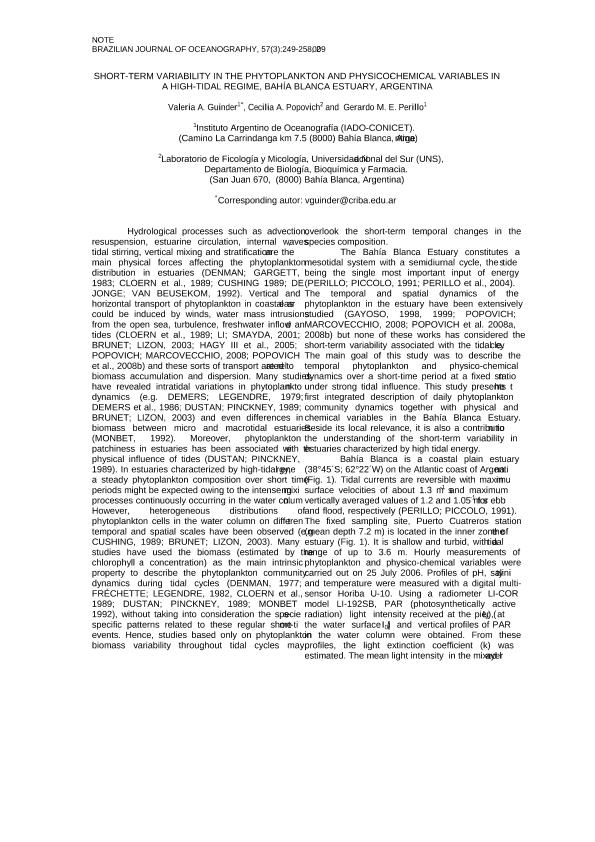Artículo
Short-term variability in the phytoplankton and physico-chemical variables in a high-tidal regime, Bahía Blanca Estuary, Argentina
Fecha de publicación:
12/2009
Editorial:
Instituto Oceanográfico
Revista:
Brazilian Journal of Oceanography
ISSN:
1679-8759
e-ISSN:
1982-436X
Idioma:
Inglés
Tipo de recurso:
Artículo publicado
Clasificación temática:
Resumen
Hydrological processes such as advection, resuspension, estuarine circulation, internal waves, tidal stirring, vertical mixing and stratification are the main physical forces affecting the phytoplankton distribution in estuaries (DENMAN; GARGETT, 1983; CLOERN et al., 1989; CUSHING 1989; DE JONGE; VAN BEUSEKOM, 1992). Vertical and horizontal transport of phytoplankton in coastal areas could be induced by winds, water mass intrusions from the open sea, turbulence, freshwater inflow and tides (CLOERN et al., 1989; LI; SMAYDA, 2001; BRUNET; LIZON, 2003; HAGY III et al., 2005; POPOVICH; MARCOVECCHIO, 2008; POPOVICH et al., 2008b) and these sorts of transport are related to biomass accumulation and dispersion. Many studies have revealed intratidal variations in phytoplankton dynamics (e.g. DEMERS; LEGENDRE, 1979; DEMERS et al., 1986; DUSTAN; PINCKNEY, 1989; BRUNET; LIZON, 2003) and even differences in biomass between micro and macrotidal estuaries (MONBET, 1992). Moreover, phytoplankton patchiness in estuaries has been associated with the physical influence of tides (DUSTAN; PINCKNEY, 1989). In estuaries characterized by high-tidal energy, a steady phytoplankton composition over short time periods might be expected owing to the intense mixing processes continuously occurring in the water column. However, heterogeneous distributions of phytoplankton cells in the water column on different temporal and spatial scales have been observed (e.g. CUSHING, 1989; BRUNET; LIZON, 2003). Many studies have used the biomass (estimated by the chlorophyll a concentration) as the main intrinsic property to describe the phytoplankton community dynamics during tidal cycles (DENMAN, 1977; FRÉCHETTE; LEGENDRE, 1982, CLOERN et al., 1989; DUSTAN; PINCKNEY, 1989; MONBET 1992), without taking into consideration the speciesspecific patterns related to these regular short-time events. Hence, studies based only on phytoplankton biomass variability throughout tidal cycles may overlook the short-term temporal changes in the species composition.
Palabras clave:
Physico-Chemical Variables
,
Phytoplankton
,
Bahía Blanca Estuary
Archivos asociados
Licencia
Identificadores
Colecciones
Articulos(IADO)
Articulos de INST.ARG.DE OCEANOGRAFIA (I)
Articulos de INST.ARG.DE OCEANOGRAFIA (I)
Citación
Guinder, Valeria Ana; Popovich, Cecilia Angelines; Perillo, Gerardo Miguel E.; Short-term variability in the phytoplankton and physico-chemical variables in a high-tidal regime, Bahía Blanca Estuary, Argentina; Instituto Oceanográfico; Brazilian Journal of Oceanography; 57; 3; 12-2009; 249-258
Compartir
Altmétricas




